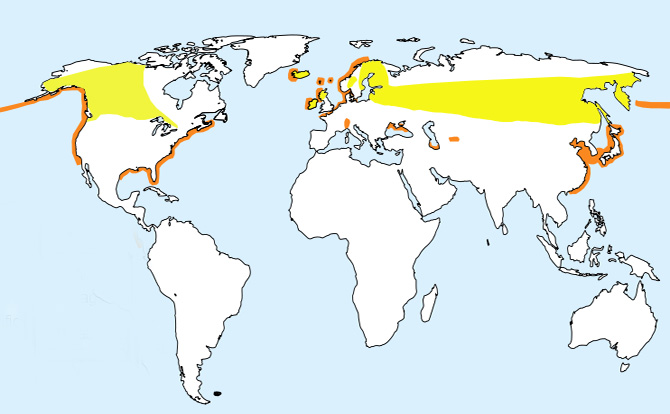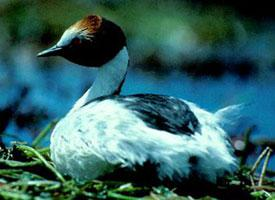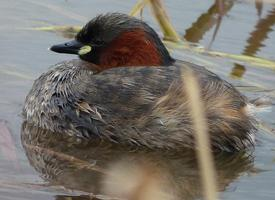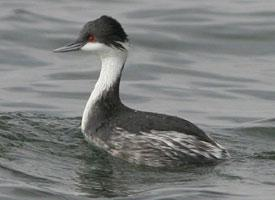
Description de l'animal
The Horned Grebe, scientifically known as Podiceps auritus, is a fascinating and visually striking bird species belonging to the grebe family. This small to medium-sized bird is renowned for its distinctive breeding plumage and intriguing behaviors. The name "Horned Grebe" is derived from the conspicuous yellowish to golden feathers that protrude from the bird's head like horns during the breeding season, creating a remarkable and unforgettable sight.Adult Horned Grebes typically measure between 31 to 38 centimeters in length, with a wingspan that ranges from 46 to 55 centimeters. They have a compact body, a relatively short tail, and a long, slender neck, which gives them a graceful appearance. Their bill is straight and pointed, perfectly adapted for catching fish and small aquatic invertebrates.
The most striking feature of the Horned Grebe is undoubtedly its breeding plumage. The head and neck are adorned with rich, dark colors, contrasted with bright red eyes that seem to pierce through the water. The "horns" – which are actually elongated tufts of feathers – can be black or yellowish, depending on the individual and the light. The body is predominantly dark with a dramatic contrast of white on the flanks, which becomes more pronounced during courtship displays.
Outside the breeding season, Horned Grebes undergo a transformation, and their plumage becomes more subdued. Their bodies are mainly dark grey, with paler undersides and less conspicuous head markings. However, even in this more muted state, they retain their sleek and elegant appearance.
Horned Grebes are excellent swimmers and divers, using their lobed feet positioned far back on their bodies to propel themselves underwater in search of food. Their diet consists mainly of small fish, aquatic insects, and crustaceans. They have a remarkable ability to adjust their buoyancy, allowing them to sink silently below the water's surface without creating a splash, making them adept hunters.
Breeding typically takes place in shallow freshwater environments, where Horned Grebes construct floating nests anchored to submerged vegetation. Both parents are involved in the incubation of the eggs and the care of the young. The chicks are precocial, meaning they are relatively mature and mobile from the moment of hatching. They are often seen riding on their parents' backs, nestled among the feathers for warmth and protection.
Horned Grebes are migratory birds, with their breeding range extending across the northern parts of North America and Eurasia. In winter, they migrate to the coasts, where they can be found in sheltered bays and estuaries. Despite facing threats from habitat loss, pollution, and entanglement in fishing gear, Horned Grebes have managed to maintain relatively stable populations in many parts of their range, although they are considered vulnerable in some areas.
In summary, the Horned Grebe is a remarkable and beautiful bird, admired not only for its striking appearance but also for its fascinating behaviors and adaptability. Its presence in wetlands and coastal areas adds to the biodiversity and ecological richness of these habitats, making it an important species for conservation efforts.
Carte de répartition

Animaux similaires
Nouvelles photos d'animaux
Top 10 des animaux
- Dolphin gull (Leucophaeus scoresbii)
- Japanese macaque (Macaca fuscata)
- Stone loach (Barbatula barbatula)
- Greek tortoise (Testudo graeca)
- Russian tortoise (Testudo horsfieldii)
- Galápagos tortoise (Geochelone nigra complex)
- Diana monkey (Cercopithecus diana)
- Moustached guenon (Cercopithecus cephus)
- Common flying dragon (Draco volans)
- Galápagos penguin (Spheniscus mendiculus)


